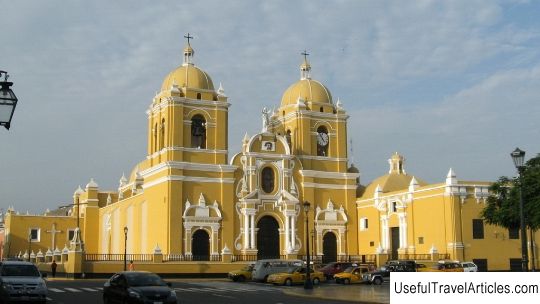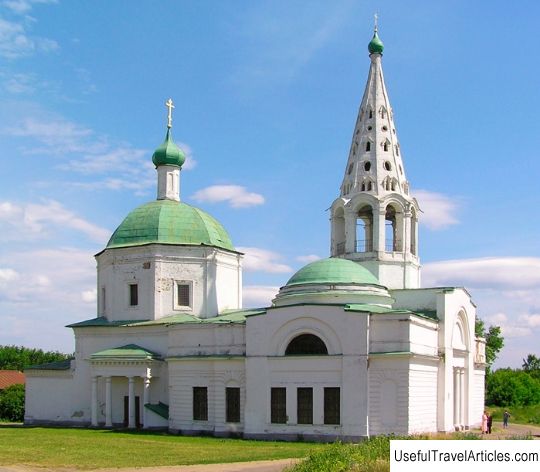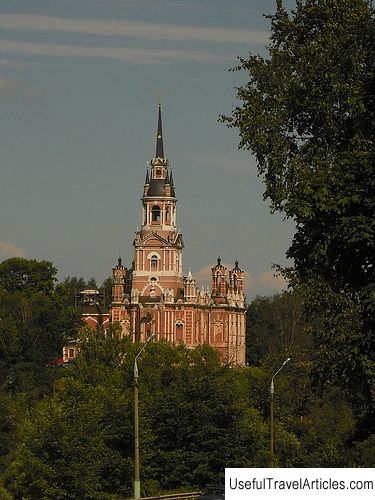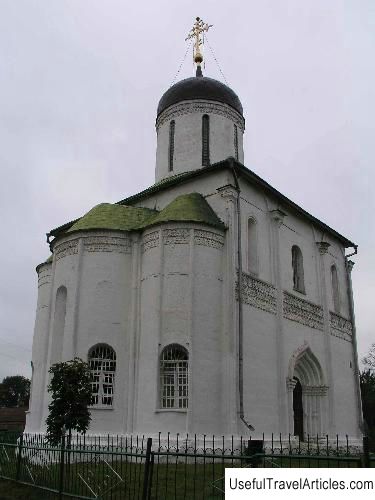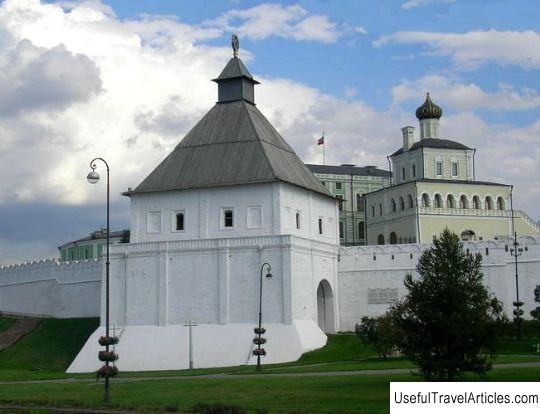Zaraisk Kremlin description and photo - Russia - Moscow region: Zaraisk
Rating: 8,2/10 (356 votes) 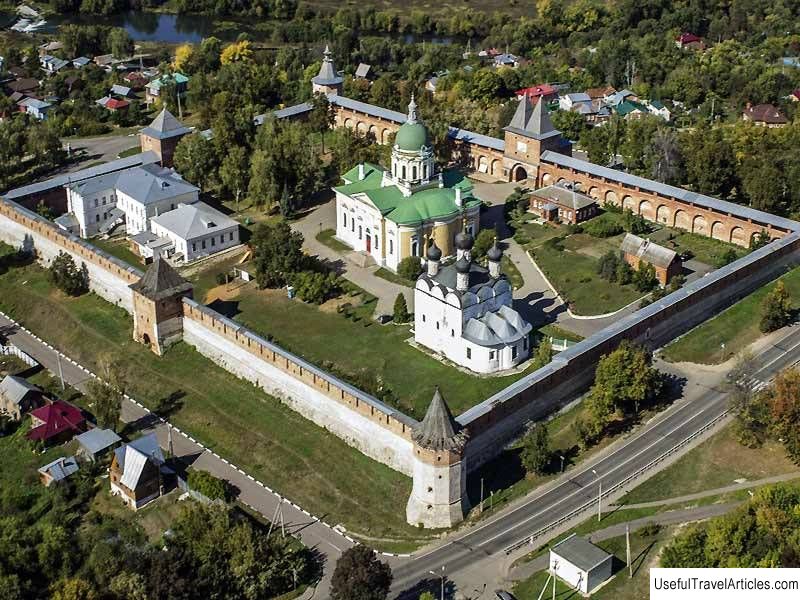
Zaraisk Kremlin description and photo - Russia - Moscow region: Zaraisk. Detailed information about the attraction. Description, photos and a map showing the nearest significant objects. Photo and descriptionThe Zaraisk Kremlin is small - but it is a real fortress of the 16th century, which has repeatedly withstood the raids of the Tatars from the Crimean Khanate. There are two cathedrals and a museum in it, and one of the cathedrals contains an ancient miraculous icon of St. Nicholas Zaraisky. Mammoth huntersOn the territory of the Zaraisk Kremlin, the most ancient traces of man in the Moscow region are recorded. The so-called " Zaraisk site " was discovered literally a few meters north of the earthen ramparts. In the 1980s-90s, excavations were carried out here. The age of the Zaraisk settlement is approximately 15-20 thousand years . Ancient people lived in dugouts, and mammoth bones played the role of floors. Hearths found utility pits (mammoth bones again served as pit lids), many tools. There are so many bones here that scientists assume that the ancient people did not hunt so much as ravaged the mammoth cemetery located somewhere nearby. The most interesting finds are works of art from the Paleolithic era : a realistic figurine of a bison and statuettes of women - “venus” carved from bone. Now most of the finds can be seen in the Zaraisk Museum. Zaraisk Fortress The original name of the city was Novogorodok-on-Sturgeon . It was a trading town south of Moscow. The first mentions of a settlement on the Osetra River in chronicles date back to XII century . According to legend, it was here that the residence of the Ryazan prince Fyodor was located at the time of the invasion of Batu. Then this place was called the village of Krasnoye. In the first third of the 16th century, it was necessary to urgently strengthen the southern borders of the Moscow lands - there were regular raids by the Horde. Strengthening in the south, the Crimean Khanate wants to regain control over the Russian lands. Vasily the Dark in response builds fortresses in Tula, Serpukhov, Kolomna and here on Sturgeon. By his order, wooden fortifications are replaced with stone ones. This takes place in 1528-1531, and already in 1533 and 1541 the city withstands the siege of the Horde. It is called now the city of Nikola Zarassky or Zaraysky, and then simply Zaraysky. The origin of the name is debated. The word "infection" could not mean disease, but an impassable thicket or ravine. According to another version, the name means "behind the duckweeds", that is, "beyond the swamps" - this is how the inhabitants of Ryazan called the city. According to the third version, the name is connected with the fact that it was here that Princess Eupraxia of Ryazan was killed, “infected” so as not to be captured by Batu. One way or another, since the 16th century the city has been called Zaraysk. The fortress was rectangular, with seven towers and three gates (in the 18th century, more were pierced). The sides of the rectangle are 185 and 125 meters. For two hundred years, the fortress has been successfully repelling the raids of the Tatars, but during the time of troubles the Poles manage to occupy it and plunder it. The city has preserved a mound, poured over the bodies of those killed in an attempt to liberate the city. In 1610-11 Zaraysk was liberated. The famous Prince Pozharsky was appointed its governor. The last hostilities took place here in 1673. The fortress repels another attack of the Tatars, and in memory of this the Kazan icon of the Mother of God is placed on the gate. From this moment the fortress loses its military significance. But, unlike many dilapidated Kremlin near Moscow, they did not disassemble it, but preserved it. Nikolsky Cathedral The wooden St. Nicholas Cathedral was replaced by a stone one at the same time when the fortress itself was built, in 1528. Tradition connects the founding of the cathedral with the 13th century. It is believed that in 1225 "in the Ryazan limits" was transferred the miraculous image of St. Nikolay from Korsun , that is, Chersonesos. The image went to the Ryazan prince Fyodor Yurievich . When the hordes of Batu came to Russia, the prince himself was killed, and the princess Eupraxia , together with the child, threw herself from a high tower, “infected”. Since then, the icon has become the image of "Nikola Zarassky". The current building was built in 1681 under Fyodor Alekseevich - it is no longer stone, but brick. The painting of the cathedral was renewed twice - in 1760 and 1849, some of the 19th century murals have survived to our time. The cathedral was closed in 1928. Former rector of the cathedral, Fr. Ioann Smirnov tried to resist this: he collected signatures of parishioners, campaigned for the opening of the cathedral, and then was arrested and shot at the Butovo training ground. Now he is canonized as a new martyr. The building of the cathedral during the Soviet years belonged to the museum - it housed funds and the museum archive. In the 1970s, the cathedral was put under state protection and restored. Since 1992 it has been handed over to believers. Nikola ZaraiskyThe main shrine of the cathedral is that very ancient miraculous icon of Nikola Zaraisky . The day this icon was transferred from Korsun - July 29 (or August 14 in the new style) - was a citywide holiday. On this day, the "Tale of Nikolas Zaraisky" was solemnly read and a memorial service for the prince's family was served, and then they walked in procession to the source. According to legend, this source, " White well ", appeared exactly at the place of the solemn meeting of the Korsun icon. Now this source, located north of the Kremlin, is still considered miraculous. A chapel was restored above it and a baptismal font was built. The icon was a large image of St. Nicholas "with brands", that is, surrounded by episodes from his life. It has been repeatedly rewritten and updated over the centuries - this was considered the norm. The image itself was revered, but the artistry of the image was of little interest to anyone. The last time it was "repaired" was in 1797 - at the same time a corresponding inscription was made about it. The icon was decorated with a precious setting, which also had an inscription about the donor - it was Tsar Vasily Shuisky , and the setting was created in 1608. However, by the 19th century, the setting was double: the very image of St. Nicholas in a gold setting with stones and pearls, made by Shuisky and the hallmarks - in a silver frame with gilding. Of course, the frames have not survived. But the icon itself survived - it was transferred to the local museum of local lore, and in 1966 - to the museum. Andrei Rublev in Moscow. In the museum, it was cleared of later strata and returned to its original appearance. In 2013, the icon was returned to believers and is now in the Nikolsky Cathedral. A lot of controversy was connected with this - the icon is very ancient and requires special storage conditions. It is placed in a special capsule, where the necessary microclimate is maintained, and its condition is monitored by specialists from the Zaraisk Museum. Cathedral of the Beheading of John the Baptist The second cathedral of the Zaraisk complex was built on the site of the legendary burial place of the Ryazan prince Fyodor and his family. The building itself was changed several times. Initially, the temple was wooden, then it became stone - since 1525, earlier than Nikolsky. In the middle of the 16th century, it was dismantled and a new one was made, by the forties of the 18th century it was dilapidated again and the next temple was built, already brick. There is a correspondence that the construction is being delayed due to a lack of bricks. Apparently, there was not enough money for high-quality building materials: in 1818 it did not even decay - it simply fell apart. The next church, in the Empire style, was built in 1822 and stood until the end of the 19th century. The new church was built 1901-1904 in the pseudo-Russian style . The architect was Konstantin Bykovsky , renowned restorer and architect. Over the centuries, the building of the temple "moved" from the prince's graves, and a separate monument in the form of three tombstones with crosses was built and consecrated above them. The money for the next restructuring was given by the Bakhrushins - a famous merchant family. The Bakhrushin family comes from Zaraysk, in the 19th century they moved to Moscow. They owned tanneries and cloth factories, did a lot of charity work, invested in the development of culture, built a lot in Moscow, but, as we see, they did not forget their hometown. In Soviet times, the bell tower was blown up , and a cinema was set up in the temple itself. The building was handed over to believers already in 1992. Until 2006, the temple was restored and is now completely put in order, the bell tower and gravestones destroyed during the Soviet years have been restored. Museum Now the museum is located in the Kremlin in the former building of "public places" , that is, the residence of the city administration in the 19th century. The building was built in the first half of the 19th century. This is a typical one-storey office building of the Classicist era. In the 20th century, it was significantly reconstructed from the inside: in almost two hundred years, the wooden floors had rotted away and in the 80s they were replaced with metal ones. Initially, city officials were housed here, then - Zaraisk theological school , then a museum. The history of the museum dates back to 1910 . Then the first museum of natural history was created in the city. In 1918, another one was created - an artistic and historical one, and in 1924 they were merged. The exposition of the Zaraisk Museum now has five halls . Here, as in many museums near Moscow, after the revolution, an extensive collection of paintings from the surrounding estates was collected. This is a Russian portrait of the 18th-19th centuries: the owners of estates, members of their families and the Zaraisk merchants. But there is also Western European painting and paintings by Russian Wanderers. A large collection of 19th century porcelain is collected here: as the largest and most famous factories, such as the Gardner factory and the Sevres manufactory, and small provincial porcelain factories. A lot of furniture came here from estates - for example, Many French furniture of the 18th-19th centuries was brought from the Sennitsa estate. Interesting factsThe Zaraisk Kremlin is the smallest Kremlin in the Moscow region. Protopop Alexei, who is in XVIII rebuilt the Cathedral of St. John the Baptist, several years before that it was flogged, because "incorrectly inscribed the royal title." Those were the strict times of Anna Ioannovna, when one could lose one's head for this ...                We also recommend reading Manavgat waterfall description and photos - Turkey: Side Topic: Zaraisk Kremlin description and photo - Russia - Moscow region: Zaraisk. |

